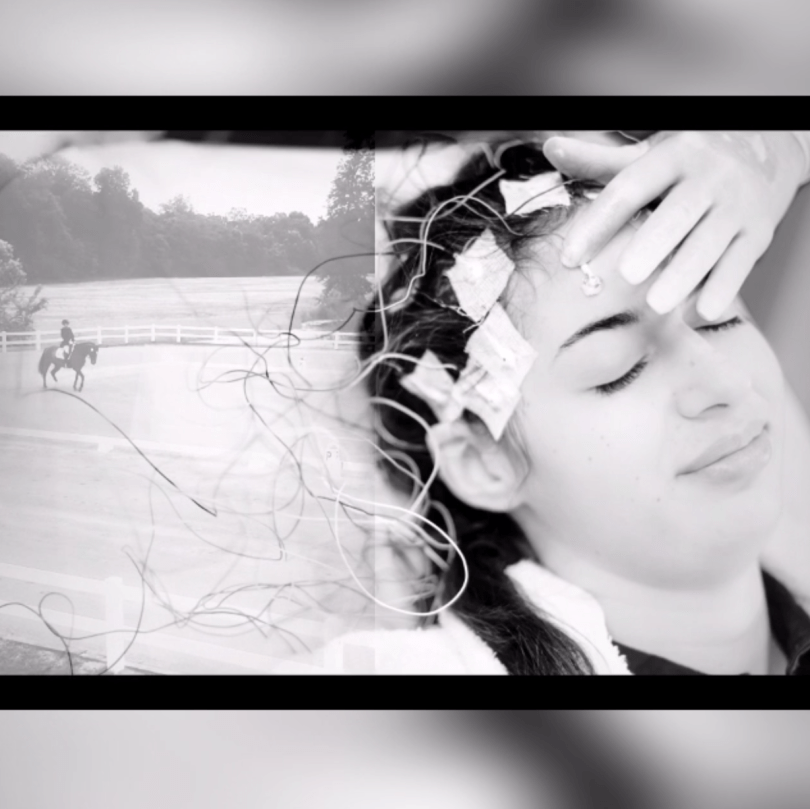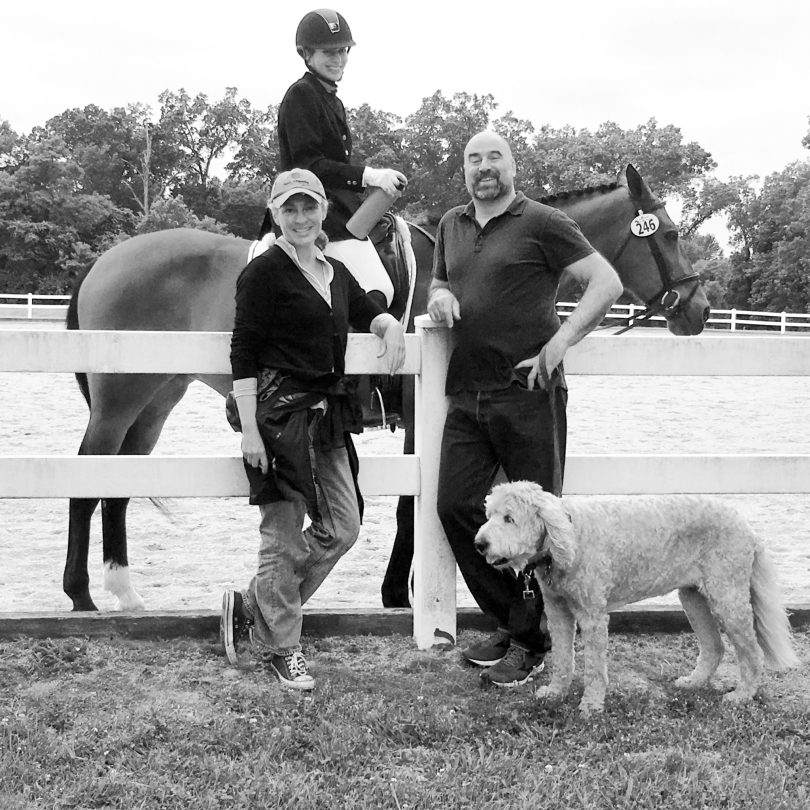
by Channing Seideman
An epilepsy diagnosis and risk of seizures while horseback riding doesn’t mean your equestrian days are over.
When people learn that I have epilepsy and ride horses, I typically hear: “Are you kidding? Isn’t that dangerous?” And it can be, unless you take the proper precautions (like wearing a Hit Air inflatable vest) to set yourself up for success.
Epilepsy is an individualized condition, and symptoms manifest themselves differently for everyone. Though epilepsy increases the chances of getting hurt while riding, because of the risk of having a seizure, there are steps you can take to mitigate that risk:
- Partner with a suitable horse
- Use proper safety equipment
- Find a supportive barn
Bottom line: you CAN ride horses with epilepsy, which I know from experience.
I’ve been living and riding with epilepsy for 16 years, and I’m going to share the three biggest tips that have impacted my journey.
3 Ways to Enjoy the Ride
1. Partner With a Suitable Horse
Some people with epilepsy can detect the onset of a seizure and react before it happens. They often describe feeling an “aura” or getting a metallic taste in their mouths.
The advantage of sensing a seizure in advance is that – as soon as you sense a seizure coming – you can get off your horse!

Remember, I said “some people” can detect seizures. Unfortunately, I’m not one of them. The good news? My horse, Perla, knows – and she’s not unique.
Many horses are incredibly intuitive and can sense when people are about to have seizures.
When I have a seizure, or am about to, Perla will do whatever it takes to keep me safe and sound.
One time, for example, we were on course at a local hunter/jumper show when I lost my vision going over a fence. Perla dropped to a walk and brought me to the in-gate where my trainer, family, and best friend were waiting.
Perla and I have a special relationship, and it’s been this way from the very beginning.
On a summer Colorado morning, I was preparing to show my previous mare, Lexus, when she got stung by a bee. Her poor mouth was so swollen that there was no way we were going to put a bit in there.
I needed to borrow a horse.
The only mount available was a mare named Perla, who was known to be a troublemaker and had a reputation of tossing off riders she didn’t like. (#mareproblems)
Everyone thought I was crazy to get on her. But, from the moment we walked into the arena, it was obvious to everyone that we were a perfect match.
Ten years later, I have yet to receive a dressage score sheet on which the judge didn’t scribble something to the effect of, “Great pair!”


Not all horses are suitable for riders with epilepsy, and it may take a few tries to find your perfect fit. Ask yourself:
- How intuitive is your horse?
- How do you think she would react if you have a seizure while riding?
- Will she slow to a walk, hug the rail, and bring you to safety?
- Will she freak out at the first sign of trouble and put you in greater danger?
- Do you trust this horse under pressure?
These are questions any rider with epilepsy, or any other health issue, for that matter, needs to ponder. Your diagnosis doesn’t mean you have to stop riding – but it may mean you should consider switching horses.
2. Use Proper Safety Equipment
Horse riding is a risky sport, and safety equipment is a big part of staying safe. When you’re at risk for seizures, however, the quality of your safety gear matters even more.

Let’s talk about three things I never ride without:
A. Helmet
This should be a no-brainer (pun intended), but many equestrians still ride without helmets. Wearing a SEI/ ASTM-certified helmet is the number one way you can protect yourself in the event you have a seizure while riding.
As mentioned in this article about how often to replace horseback riding helmets, this vital piece of gear:
- Has a hard outer shell designed to protect your head from being cut by sharp objects (e.g. hoof)
- Features a smooth exterior to help your head slide across the ground and increase stopping room
- Reduces the force of an impact on your skull with its crushable foam interior
Pro Tip: Don’t be afraid to have a professional make sure your helmet fits properly.
Plus, replace your helmet any time you fall off your horse — even if there’s no visible damage. (The internal structure can be compromised.) If you go five years without a fall, a) congrats and b) it’s time to replace your helmet anyway!

B. Safety Stirrups
Safety stirrups are another must-have for epileptic equestrians. (In fact, I’d recommend them for everyone.)
Whether we’re talking about beginner riders with twisted rubber bands on the outside of the stirrups, or a professional rider with the latest and greatest Freejump Pro stirrups, safety stirrups are designed to keep your feet from getting caught in the stirrup.
Check out the 7 Best Safety Stirrups for Adults so you can make an educated purchase decision.
If you’re riding with epilepsy, your chances of losing your balance during a seizure and being unable to release your feet from regular stirrups increases tenfold.
Investing in a pair of solid safety stirrups will put your mind at ease — and keep you from getting dragged by your horse.

C. Inflatable Air Vest
Once you’ve got your helmet and safety stirrups, you’re good to go ride into the sunset, right? Not so fast.
Safety technology has come a long way, and today’s riders should take full advantage. Adding an inflatable air vest to your safety trifecta is a wonderful way to protect your neck, back, ribs, tailbone, and other internal organs in the event of a fall.
“Aren’t air vests only for eventers?” you might ask. Though that’s the most common discipline to spot these innovative vests, plenty of other riders wear them, too.
Whether you’re riding trails or working cows, stadium jumping or simply riding out on your own, air vests are increasing in popularity.
I chose a Hit-Air Vest because it’s fairly flat and conforms to my body, which means it doesn’t interfere with my riding. Inside the vest is a small cartridge filled with compressed nitrogen that – when I separate from the saddle – inflates the vest in .09 seconds.
By the time I hit the ground, the vest is fully inflated and protects my back, neck, and internal organs.
Take my word for it: these vests work. Mine has saved me 10 times because I’ve gone through 10 cartridges!
(The vest can be deflated and snapped back together after a fall, so you only need to replace the cartridge — not the vest.)
I may look a bit silly wearing what looks like an inflated sumo suit after a fall, but it sure beats serious injury and all the bumps and bruises.
For English riders who compete and dislike the look/feel of a separate air vest, Freejump has created an airbag show jacket. (This technology is also used in other dangerous sports, such as skiing and motorcycling, and acts similar to the Hit-Air vest.)
Air vests are an investment (check the price at Amazon), but I’ve saved far more by avoiding trips to the ER!
3. Find a Supportive Barn
Epilepsy has a notorious partner in crime — stigma. You deserve to have a “barn family” that understands your condition, respects your decision to continue riding, and knows how to help if you need assistance.
Finding a supportive barn environment is critical.
My family and I have found that openness and honesty are key. Approach stable management with your situation and get a feel for their reaction.
If they’re welcoming, great. If not, it may be worth considering a different barn.

(We drive 45 minutes one-way because the barn I’m at now is so supportive!)
Once you find the right barn, that same openness and honesty is important when meeting fellow boarders and riders. When those around you feel informed and prepared, they’re less fearful of your epilepsy.
Being ill-informed (or misinformed) is a sure-fire way to increase the stigma around horse riding with epilepsy.
We created wallet-sized cards containing medical, contact, and physician information, as well as step-by-step first aid instructions.
These quick-reference cards spell out exactly what to do, and – just as importantly – what not to do in the case I have a seizure. Many of the boarders keep the cards with them, and they’re also pinned to cork boards throughout the barn for easy access.
Over time, everyone at Majestic Farm has come to not only accept and support me as a rider, but they also work alongside me to raise awareness through events like our Dressage for a Cause schooling show, which is a fundraiser for research in finding a cure for epilepsy.
Frequently Asked Questions
Q: Is it safe to ride horses with epilepsy?
As long as you take the right precautions, horseback riding is still an option for those with epilepsy.
Those precautions are as varied as the individual, but scroll back to the top of this blog to read about the three key precautions I take:
- Quality helmet
- Safety stirrups
- Hit-Air vest
Q: What happens during an epileptic seizure?
There are many different types of seizures, and epilepsy is highly individualized. That’s why it’s hard to describe what manifests on the outside.
On the inside, however, what’s happening is similar to what happens when a computer freezes and the dreaded Apple pinwheel pops up on your screen.
The brain essentially goes into overload and shuts down. Just like a computer, once it’s rebooted, everything (hopefully!) returns to normal.
For me, personally, I have three types of seizures:
- Tonic-clonics that are convulsive seizures that, if they last more than five minutes, require an emergency room visit.
- Myoclonic jerks that are brief and include my shoulders or head jerking.
- Absence seizures where I blank out or daydream for just a few seconds.
That said, an epileptic’s seizures can change over time.
I’ve not always been limited to the three types of seizures listed above. I’ve also experienced drop seizures, gasps, as well as seizures that caused the loss of certain senses, such as the inability to see, speak, and/or move.
You can learn more about types of seizures from Epilepsy Foundation.
Q: What can trigger an epileptic seizure?
Stress and lack of sleep are common triggers. Others include strobe lights, excessive heat, and even menstrual cycles.
But, sometimes seizures just happen. That’s one of the toughest parts of living with them.
Epilepsy has even been characterized as “terrorism of the brain” because you never know when it’s going to strike, and it affects everyone and everything around you.
Q: What does an epileptic seizure feel like?
Some people are conscious and aware during their seizures. I’m not aware during my tonic-clonics (thank goodness!). The myoclonic jerks feel like they look — twitches and jerks.
Sometimes I’m aware during my absence seizures, and I can hear and see people, but I can’t respond
Q: Can you feel a seizure coming on?
Some people can sense the onset of a seizure, but I can’t.
As I mentioned earlier in the article, the good news is that many horses are so intuitive that they can sense the onset of their rider’s seizure.
I’m lucky because my horse, Perla, knows when I’m about to have one, and she’ll do whatever it takes to keep me safe.
Q: What are the warning signs of having a seizure?
Some people experience what they refer to as an aura. Some people get a weird taste in their mouth.
Others, like me, don’t have any warning signal.
Q: Can exercise cause seizures?
Exercise is great because it reduces stress, which can otherwise be a trigger. Exercise is also great because it helps you sleep better. (Lack of sleep is also a seizure trigger.)
Exercise, however, also results in an increase of body heat and dehydration, which can aggravate the side-effects of many epilepsy medications.
Overall, horse riding is great exercise and helpful for your mind and body — with the proper precautions!
Q: What should I do while someone is having a seizure?
It’s important for your own safety that everyone at your barn know what to do, and confidence also increases their comfort level with your condition.
If someone is having a seizure, DO:
- TIME the seizure with your watch (or phone stopwatch)
- LOOK for medical identification
- PROTECT from nearby hazards
- LOOSEN ties or shirt collars
- PLACE folded jacket under head
- TURN ON SIDE to keep airway clear
If someone is having a seizure, DO NOT:
- DON’T put anything in the mouth
- DON’T restrain
- DON’T try to hold the tongue (it cannot be swallowed)
- DON’T try to give liquids during or just after a seizure
- DON’T use artificial respiration, except in the unlikely event that a person does not start breathing again after the seizure has stopped
- CALL an ambulance ONLY if the seizure lasts longer than 5 minutes or another starts soon after the first
Q: What should I do after someone has a seizure?
Reassure the person when consciousness returns. Allow them space until they begin to become reoriented with their surroundings.
Rescue medication such as Ativan may be required in some instances. For me, make sure food is available!
Epilepsy Doesn’t Define You
Riding is an inherently risky sport, and perfectly healthy people can get hurt.
Personally, it’s not a big deal to keep riding with epilepsy. After all, it could be worse… I could have chosen competitive swimming, or sky diving!

Plus, I feel like I owe it to those people whose epilepsy is so severe that they can’t ride at all to keep living my dream.
In addition to loving riding more than anything else in the whole world, I ride for those who can’t.
In that sense, I’m lucky. While I suffer so many more setbacks than most of my fellow riders, I’m fortunate in that I get to experience the unbreakable bond between horse and rider. #epilepsywarrior
About Channing Seideman
Channing Seideman is an advocate for quality of life for people with epilepsy. Channing is 26 and has lived with epilepsy – and ridden with epilepsy – since she was 9, refusing to let her condition define her life. When it threatened her goals as a competitive horse jumper, she started wearing an inflatable vest to protect her from falls due to seizures. When epilepsy threatened to keep her from finding meaningful employment in the health industry, she became a medical transcriptionist. Now, Channing works at the non-profit, May We Help.
This article originally appeared on Horse Rookie and is published here with permission.
Find more interesting articles in our section on Health & Education.

































